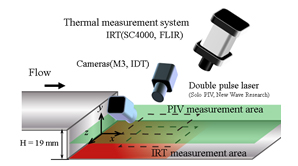Newsletter 2016.11 Index
Theme : "Mechanical Engineering Congress, 2016 Japan (MECJ-16)"
|
Simultaneous Measurement of Velocity and Heat Transfer in Unsteady Flow and Thermal Fields near the Wall Region
Shunsuke YAMADA,
|
Abstract
The problem of heat transfer has both practical and technical interest such as global warming, the effective utilization of energy resources and the increasing of heat flux density at the chip level in electronics package. The separated and reattachment flow appears in the inside of the thermal fluid machine due to the step of the internal wall and the adverse pressure gradient. So the cooling and driving efficiency decreases by the recirculation region. The unsteady characteristics of the flow and thermal fluctuations are observed around the separation and reattachment point, and this mechanism is very complex. It is important to clarify the relationship between the unsteady velocity and heat transfer fluctuations from transition to turbulent flow region. In the present study, simultaneous measurement of flow and heat transfer fluctuations downstream a backward facing step in the near-wall region is presented. The instantaneous flow and convective heat transfer profiles were experimentally measured using two-dimensional, three-component (2D-3C) PIV system and a high-speed infrared thermography (IRT) combined system at the same time as shown in Figure 1. Using this measurement system, the unsteady flow behaviour in the vicinity of the heated wall and the heat transfer on the heated wall were investigated at the Reynolds number range of 2.5 × 103, which is based on the step height, H = 19 mm and main stream velocity, u0. Figure 2(a) to 2(c) show the instantaneous distribution of the streamwise, transverse and spanwise velocity, u/u0, v/u0 and w/u0 at y/H = 0.06 in xz cross section and heat transfer coefficient, h [W/m2K]. The solid and dash lines present the positive and negative of the velocity value. In Figure 2(b), the increasing of the heat transfer corresponds to the negative value of the transverse velocity spatially. However, the spatially corresponding relationship between the streamwise and spanwise velocities and heat transfer coefficient are not confirmed in this region. The results showed that the downwash flow appears to enhance the heat transfer in the near-wall region.
Key words
Stereoscopic PIV, Infrared thermography, Simultaneous measurement, Backward Facing Step
Figures

Fig.1 Schematic diagram of camera arrangement
 |
||
| (a) Streamwise velocity | (b) Transverse velocity | (c) Spanwise velocity |
Fig. 2 Corresponding relationship between Instantaneous flow and heat transfer
(ReH = 2.5 × 103, y/H = 0.06)



